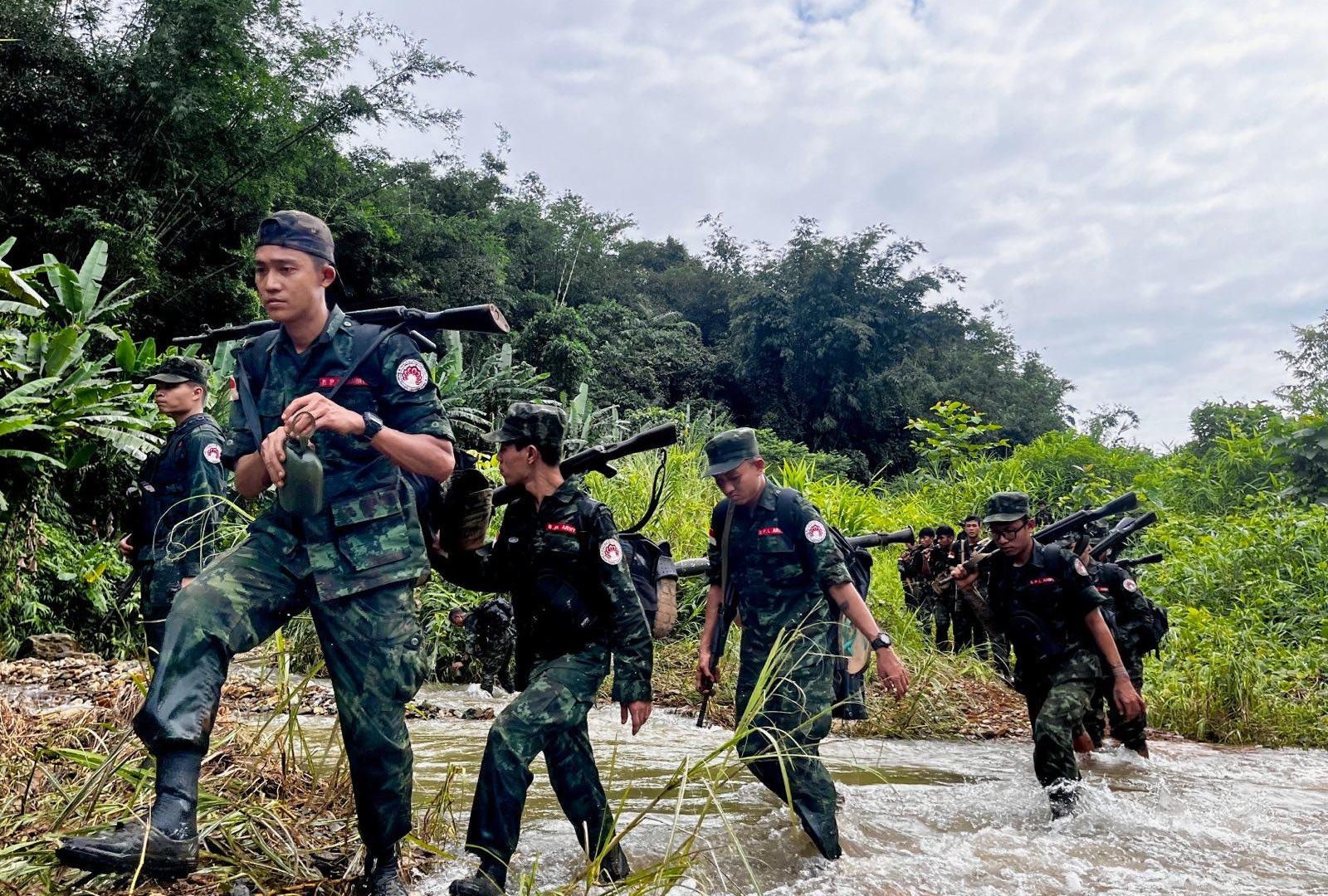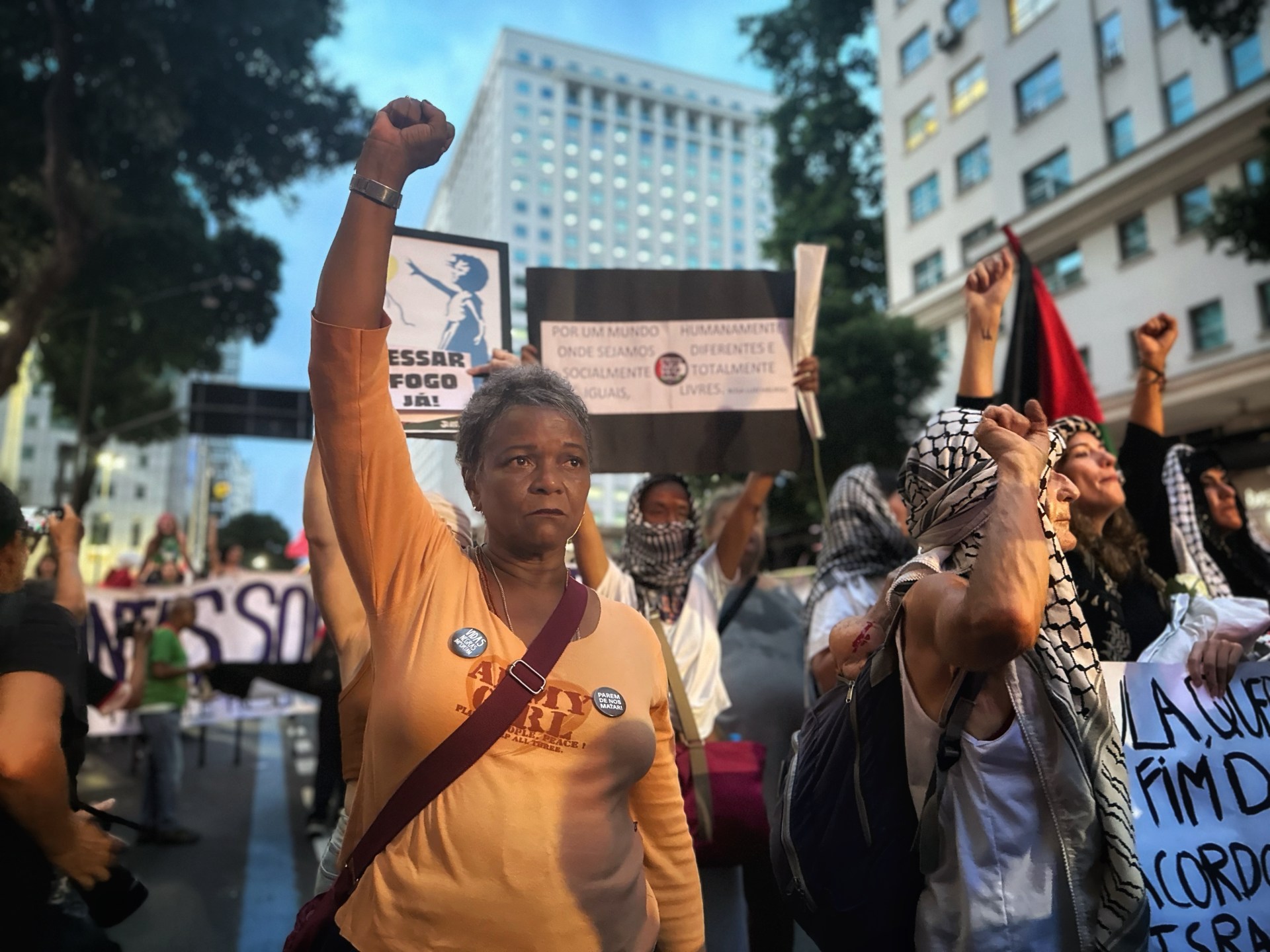Northern offensive brings ‘new energy’ to Myanmar’s anti-coup resistance
A week ago, one of Myanmar’s most powerful ethnic armed alliances launched a coordinated attack on a dozen military outposts in northern Shan State, along the country’s eastern border with China.
Code-named Operation 1027, the plan is to assert and defend territory against Myanmar military incursions, eradicate “oppressive military dictatorship”, and combat online fraud along the border, according to a statement from its organisers, the Three Brotherhood Alliance.
Made up of the Myanmar National Democratic Alliance Army (MNDAA), Ta’Ang National Liberation Army (TNLA) and Arakan Army (AA), the alliance is part of a coalition of seven ethnic armed organisations which maintain close ties with China and have bases or territories near the country’s border.
A particular target of the operation is the cyber-scamming industry that has boomed in autonomous militarised zones on Myanmar’s eastern border since the February 2021 military coup, generating billions of dollars for Chinese gangs working in collaboration with the Myanmar military, its proxies and other armed groups.
A United Nations report published in August found that an estimated 120,000 people had been trafficked into the industry in Myanmar, where they are forced to scam people around the world and are subject to abuses including torture, sexual violence and other forms of “cruel, inhuman and degrading treatment”.
The industry has ensnared Chinese nationals as victims of both trafficking and scamming, and over the past year, the Chinese government has exerted increasing pressure on the Myanmar military to crack down. In recent months, China also launched a series of cross-border operations resulting in the arrest and repatriation of more than 4,500 people, according to a report published last month by the Institute for Strategy and Policy-Myanmar, an independent think tank.
While Operation 1027 offers the potential to help advance China’s objectives in relation to the cyber-scamming industry, analysts say it could also give new energy to Myanmar’s anti-coup movement, also known as the Spring Revolution, which aims to remove the military regime and establish a federal democratic union.
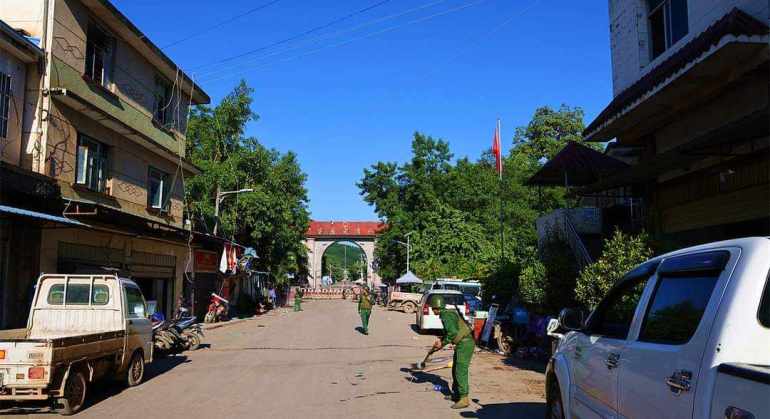
The offensive marks the full-fledged entry of the Three Brotherhood Alliance into the war, and public expectations are rising that the operation might ignite enough momentum to defeat the military once and for all.
“Operation 1027 is a big moment for the Spring Revolution, and makes it clear for the Myanmar people and those who stand on the side of truth that our revolution will win,” said Tayzar San, a prominent activist who led the country’s first demonstration against the coup.
“The fact that the Three Brotherhood Alliance is vigorously participating in the fight against the junta has greatly affected the balance of power. The strength of the revolution is rising.”
According to a statement released on Tuesday, the alliance has so far seized more than 80 military bases and taken over the border post of Chin Shwe Haw, while more than 100 military soldiers have surrendered to resistance forces. Footage posted by alliance members on social media indicates that they have also seized large caches of military weapons and ammunition.
‘Beginning of the end game’
The recent surge in fighting comes after roughly 1,000 days of violence and upheaval since Senior General Min Aung Hlaing removed the elected government of Aung San Suu Kyi. Within months, the military’s lethal crackdowns on nonviolent protests had sparked an armed uprising that has since grown to an unprecedented scale.
Several longstanding ethnic armed organisations fighting for autonomy along the country’s borders have openly armed, trained and fought alongside civilian-led forces established to drive the military from power, enduring retaliatory attacks by the military.
But until now, the Three Brotherhood Alliance had maintained a relative distance from the crisis. Instead, its members had quietly supported other groups fighting against the military, while also focusing on their own political and territorial objectives according to Victor, an independent humanitarian adviser from Myanmar with more than 10 years of experience working with ethnic armed organisations.
He said it was only a matter of time before the groups openly entered the war. “The Spring Revolution is an opportunity to eliminate the junta,” said Victor, who asked to use a pseudonym for security reasons. “This is the beginning of the end game.”
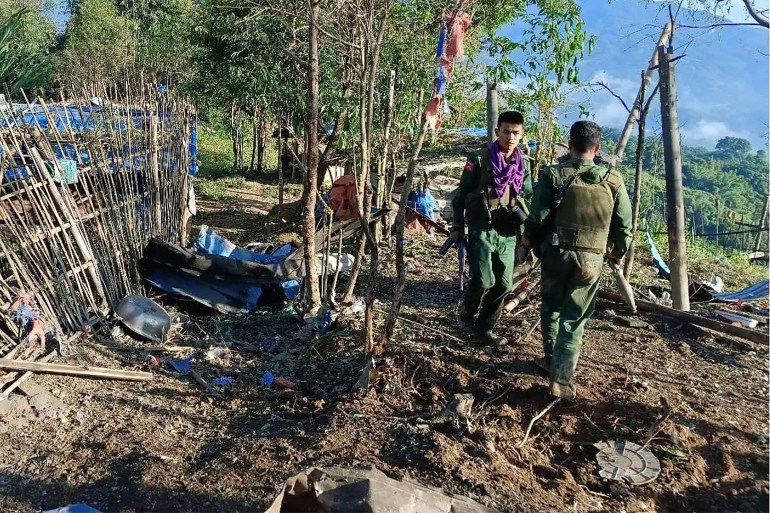
Initial reports indicate an escalating humanitarian crisis since the operation’s launch. The United Nations humanitarian office reported on Thursday that at least nine civilians had been killed and 23,000 internally displaced by armed clashes in northern Shan State over the past week.
Despite the needs, however, humanitarian access remains “extremely restricted”, according to the UN report. It said that domestic flights into the town of Lashio had been suspended and major roads blocked and that mobile communication and data services were “markedly restricted”.
People living in northern Shan described a rapidly deteriorating situation to Al Jazeera. They are using pseudonyms for security reasons.
In the city of Lashio, Ah San said on Friday that she could hear explosions but knew little about what was happening. “It’s not easy to get accurate information because I can’t leave my house. I can only use the phone, and the connection is often interrupted or cut,” she said. “I can’t do much, so I’m just staying here with worry and uncertainty.”
In the town of Kutkai, Awng Awng said on Saturday that he had lost electricity and that the fighting had blocked road access. “It seems like everyone in the town is stuck,” he said. “ People in the town aren’t safe to flee outside of the town, and those outside of the town can’t flee into the town either. It feels like the whole town has become an IDP [internally displaced people] camp.”
La Zing, who lives in the border town of Mong Ko, told Al Jazeera on Saturday that about 100 households from nearby villages had already fled, and that the situation in the town was increasingly precarious. “If the fighting continues, it will only get harder for us to live here,” he said. “Locals will face food shortages and suffer a lot.”
Myu, from the border village of Hpawng Hseng, said on Sunday that he had fled the village along with about 100 other households and that they were camping out near the border. “This morning, when I went to check on my home, I could see the remnants of exploded weapons,” he said. “Some houses and our church have already been destroyed.”
Although people interviewed by Al Jazeera were not aware of anyone who had yet crossed the border due to a barbed-wire fence that China erected during the pandemic, one source said that they might attempt to break through if the situation became desperate enough. “We are holding round pliers to cut the border fence if an urgent case arises,” they said.
Faced with a rising crisis at its border, China’s public security minister Wang Xiaohong visited Myanmar this week, meeting the military’s home minister on Monday and coup leader Min Aung Hlaing the next day. According to the Myanmar military-run media, they discussed the situation in northern Shan, bilateral cooperation and plans to jointly take action against various criminal operations.
China maintains billions of dollars worth of infrastructure investments in Myanmar and has, since the coup, continued to engage diplomatically with the military while also serving as one of its biggest arms suppliers.
Chinese officials have also convened several meetings with a coalition of powerful ethnic armed organisations based in the country’s north, including Three Brotherhood Alliance members. A statement released by the coalition in March welcomed China’s “mediation to end internal conflicts in Myanmar”.
According to Jason Tower, Myanmar Country Director with the United States Institute of Peace (USIP), China has shown a “growing willingness … to flex its muscles in influencing all of the actors involved in the revolution or the conflict in Myanmar” since the coup. “It’s important to look closely at how China is going to use that influence,” he added.
But even more than the conflict, he suggested that the cyber-scam crisis has become a dominant issue for China over the past year. “The Chinese are now very proactive on this issue,” he said. “The military junta hasn’t taken it seriously.”
Victor suggested that these dynamics offered a timely opening for the Three Brotherhood Alliance to launch its operation. “At the moment, China is really focusing on eliminating all of the online gambling and trafficking,” he said. “When the Three Brotherhood Alliance entered into the war, they used that [as an entry] point.”
But at its core, he said that the operation targets the beliefs of the people, who “are very hungry, since the Spring Revolution started, for coordinated military attacks on the junta”.
‘We are all revolutionaries’
Within hours of the operation’s launch, other resistance groups had committed their forces to the campaign.
“We are proud to participate in Operation 1027 along with the Three Brotherhood Alliance,” Ko Lin Lin, the nom de guerre of a spokesperson for the Bamar People’s Liberation Army, told Al Jazeera. Established in April 2021, the BPLA has since developed a close relationship with the Three Brotherhood Alliance and is now fighting alongside its forces.

Also joining the operation are forces under the command of the National Unity Government, a civilian administration made up of activists and politicians who oppose the coup. Last Friday, its defence ministry released a statement calling on all resistance actors and the entire Myanmar public to “fully engage in the elimination of military dictatorship and wholeheartedly commit to the establishment of a Federal Democratic Union,” while “maintain[ing] their unity throughout this journey”.
Victor said that the enthusiasm of Myanmar’s diverse resistance groups had served to “motivate the people who are fighting on the ground”, as well as inspire donations from the public. “It is a kind of rebirth of the spirit of the Spring Revolution,” he said.
Key will be how some of Shan State’s most powerful ethnic armed groups respond to the operation.
Since long before the coup, the state was racked by infighting between ethnic armed groups over competing territorial claims, economic interests and ethno-nationalist sentiments, according to Sai Wansai, a political analyst from Shan State. He told Al Jazeera that if the groups were able to come together and find common ground, they could play a pivotal role in the outcome.
The most powerful of Myanmar’s ethnic armed organisations is the United Wa State Army, which controls an autonomous territory on Myanmar’s eastern border and has so far taken a public stance of noninterference regarding the coup.
Since the launch of Operation 1027, it has reaffirmed this position but has also offered humanitarian assistance and refuge to hundreds of people displaced by the fighting. On Wednesday, it released a statement calling on parties to resolve their differences through political negotiation, while adding that it would deal “a devastating blow” in response to any incursions into its airspace or territory.
USIP’s Tower said that this and other developments indicate a potentially “unprecedented” level of coordination between Myanmar’s armed groups. “This has brought a new level of energy to resistance forces,” he said.
So far, the operation has also seen an outpouring of support from the Myanmar public.
“The military junta is already isolated and disintegrating, but Operation 1027 showed that the revolutionary groups have become more organised and united,” said activist Tayzar San. He added that the revolution is “not just on the battlefield”, but that the public should actively participate in any way they could, including through civil disobedience, protests, international advocacy and financial support.
“We, the Myanmar people, have to realise that we are all revolutionaries and comrades,” he said.
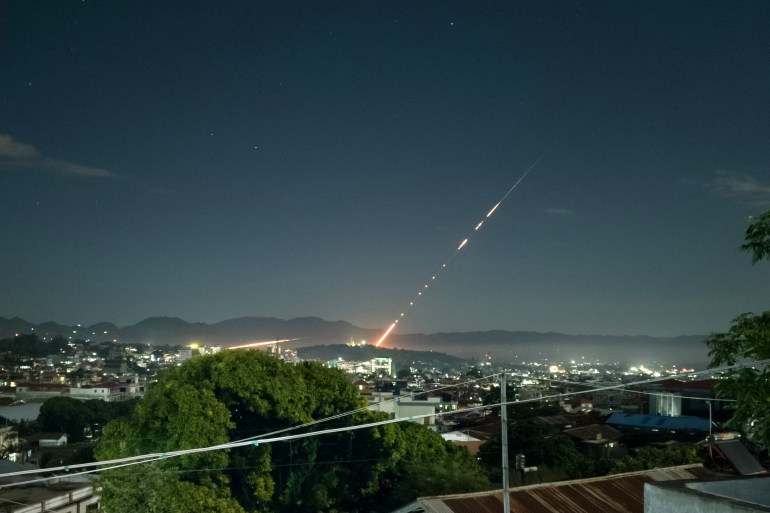
For civilians in the midst of the fighting, a desire to see the military fall is also tinged with the fear of what might lie ahead. The generals have had no qualms about unleashing their full firepower on civilians, in addition to their armed opponents.
“My greatest concern is that the military will retaliate by dropping bombs everywhere,” said Myu, in Hpawng Hseng. “Even if our people win at this point, it might not be safe for us to return home without lasting peace.”
In Kutkai, Awng Awng also expressed concern about the risks to civilians, but nonetheless pledged his support for the operation. “Although we, civilians, are facing many hardships, we can endure all of it … because this is a part of our revolution,” he said. “We understand that this is for our cause.”
Jauman Naw and Hpan Ja Brang contributed to this report.

